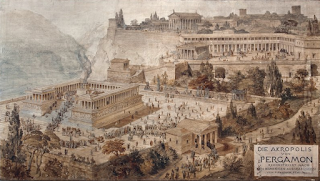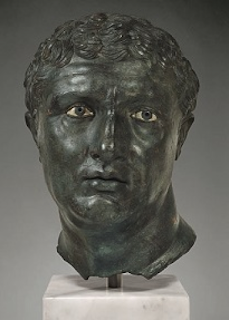The show covers the Hellenistic period from 323–30 B.C. after the conquests of Alexander the Great. It would not have been possible to put on this exhibition without the cooperation of the Pergamon Museum in Berlin, which lent approximately one third of the art works to the show. Like so many grand exhibitions it happened because the Berlin museum was closed for major renovations. The last time I was at that museum it was still East Berlin and I am ashamed to say my best memory was being pulled into a space under the grand steps to the altar where I was offered “a good deal” on East German Marks for U. S. dollars… what would you do? Other lenders to the show were museums in Greece, Italy, Morocco, Tunisia. In fact there were objects lent from 12 different countries. The catalog, which is a must if you are into this period as a collector, classicist or just a museum-goer, has about 75 contributors.
This is a very large exhibition with 265 objects. It would take days to study each one and, of course, people devote their lives to this period of archaeology. My world at the earliest starts a millennium later so I am not going to deal with the fascinating aspects of where these artifacts were found. Suffice it to say that the Hellenistic City of Pergamon was an ancient Greek city, which today, is north and west of the modern city of Bergama in Turkey. Here is a rendering of the Acropolis at Pergamon by Friedrich (Von) Thiersch (1882) from Antikensammlung, Staatliche Museen zu Berlin.
As you know if you have followed my missives, in my opinion, an exhibition stands on the works of art exhibited no matter the grand ideas the curator(s) may have had and there are so many “10’s” in this show it is very hard to choose. Just as the tallest person in a room will grab your attention so does the Statue of Athena Parthenos dating from circa 170 B.C. lent by the Berlin museum. This marble is over 10 feet tall with an additional 3 foot stand. As you can see in the following image it towers above all.
I have often thought of Classical Antiquities merely as fragments and I usually like the finished work of art better, but sometimes an incomplete piece such as a painting or sculpture can even be more exciting as was shown by the strange exhibition “Unfinished Thought Left Visible”.
Some of the works of art in the Pergamon show appear unfinished today though originally they were finished and a couple of thousand years, and sometimes burial, took their toll! For instance, the bronze “Portrait of a Man” from the Greek, Late Hellenistic Period lent by the National Archaeological Museum in Athens is assumed to be a fragment of a statue from an open public space. I am sure it has much more poignancy and focus with just the head staring at you or just beyond!
What struck me most was how so many objects seemed to relate to later periods. The small bronze of “Alexander the Great Astride Bucephalos” Roman, Late Republican or Early Imperial period, second half of the 1st century BC, is already a copy of a Greek original made 200 years earlier. Yet there are very similar Renaissance bronzes of horses and riders done in the 16th century as well, such as the bronze of horse and rider from the Met’s Collection given by Judge Irwin Untermyer.
The attraction to gold cannot be explained, but it has always been highly valued and two of the pieces here are real stunners. There is the Myrtle Wreath that would knock the socks of any Princess, Jewish or otherwise! It is Greek from the Late Classical period 350-325 B.C. lent by the Archaeological Museum, Thessaloniki in Greece. If you are into sets of Jewelry how about adding these gold armbands which I have seen before in the Met’s collection but hit me even harder in context. I would not have been surprised if you told me they were made by Bulgari a few years ago!
Ending as usual with a personal favorite three Theater Masks, Pentelic marble, 2, Greek Hellenistic period, 2nd century B.C. and the 3rd, on the left, is Greek Early Imperial Period, 1st century A.D., National Archaeological Museum, Athens. The masks were made in Attica, the birthplace of drama.
The exhibition closes July 17 so if you are in New York in the next two weeks, don’t miss it!








No comments:
Post a Comment